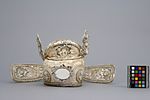kwai tauh (Cantonese Opera Headdress)
About this object
History of use
Headdresses of this kind were and are worn in Cantonese opera to represent male civil characters of various degrees of high status, from scholars to emperors. The extent and colour of decoration indicates the status of the character. Headdresses of this particular kind were and are worn to represent officials of middle rank, such as county-level officials. Both male actors and female actors with alto voices play these male roles. During the years 1900-1930, Cantonese opera costumes were decorated with silver-plated brass discs and then with round mirrors, together with gold and silver thread. Sequins made of gelatin were first used on Cantonese opera costumes in the 1930s. Heavily-sequined costumes were popular in the 1950s-60s, with the sequins then being made of plastic. Sequins have continued to come and go in popularity since that time.
Cultural context
Cantonese Opera Performance
Physical description
Stiff headdress of shiny white fabric decorated with silver sequins (a), and including four additional numerous components that insert into the central portion of the headdress. The front is rounded and flat on top, with an oval disc of white plastic at the centre front. The back half rises at a right angle to the front and is bulbous and rounded at the back. Inserted into the bottom of the centre back are two wing-like projections (b,c), rectangular with rounded corners. Also inserted into the headdress, at the sides, are two leaf-shaped projections (d,e).
Categories
Materials
Synthetic fibre? Paper? Paste adhesive? Plastic Cotton fibre Metal
